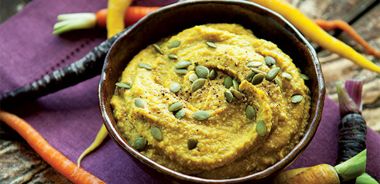Curry Lentil Squash Dip

Sweet tasting butternut squash gives this hearty dip a seasonal flair. It’s best served warm, and crispy jicama or kohlrabi are stellar sidekicks to this dip.
Better for you: Chief among the nutritional perks of butternut squash is beta carotene, an antioxidant that the body converts to vitamin A to bolster immune, eye, and bone health. Pumpkin seeds deliver a healthy dose of magnesium, believed to be particularly helpful at fending off type 2 diabetes.
3 cups (750 mL) cubed butternut squash
1/2 cup (125 mL) dry red lentils
1/2 cup (125 mL) unsalted pumpkin seeds
1 1/2 tsp (7 mL) curry powder
1/2 tsp (2 mL) cumin
1/8 tsp (0.5 mL) cayenne
1 tsp (5 mL) minced fresh ginger
1 garlic clove, minced
Juice of 1/2 lemon
1/4 tsp (1 mL) salt
1/4 tsp (1 mL) black pepper
Steam or roast butternut squash until tender.
Place red lentils and 1 1/2 cups (350 mL) water in medium-sized saucepan, bring to a boil, reduce heat, and simmer until lentils are tender, about 10 minutes. Let squash and lentils cool.
Toast pumpkin seeds in dry skillet over medium heat until browned and beginning to pop, about 2 minutes, stirring often. Place pumpkin seeds in food processor and let cool. Once cooled, blend seeds into tiny bits.
Add squash, lentils, and remaining ingredients to food processor and blend until smooth.
Serves 8.
Each serving contains: 114 calories; 6 g protein; 4 g total fat (1 g sat. fat, 0 g trans fat); 15 g total carbohydrates (2 g sugars, 5 g fibre); 77 mg sodium
source: "Take a Dip", alive #362, December 2012





